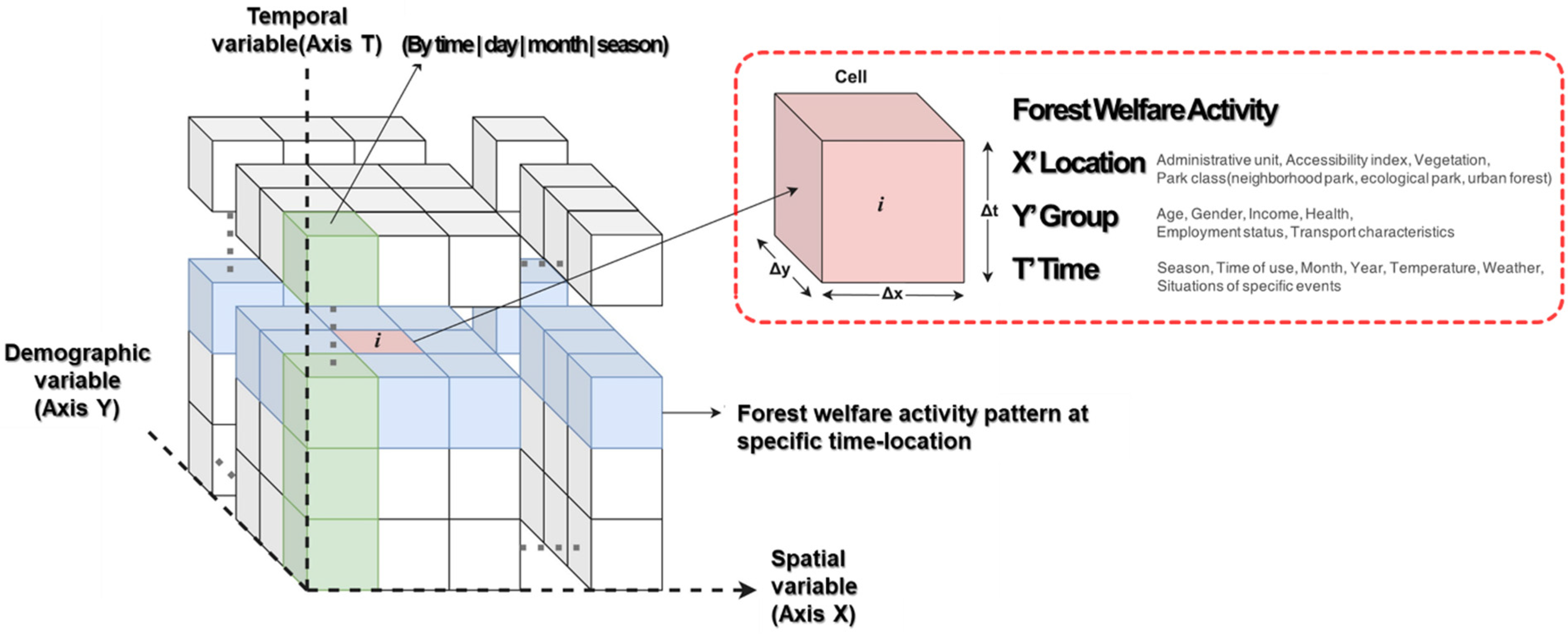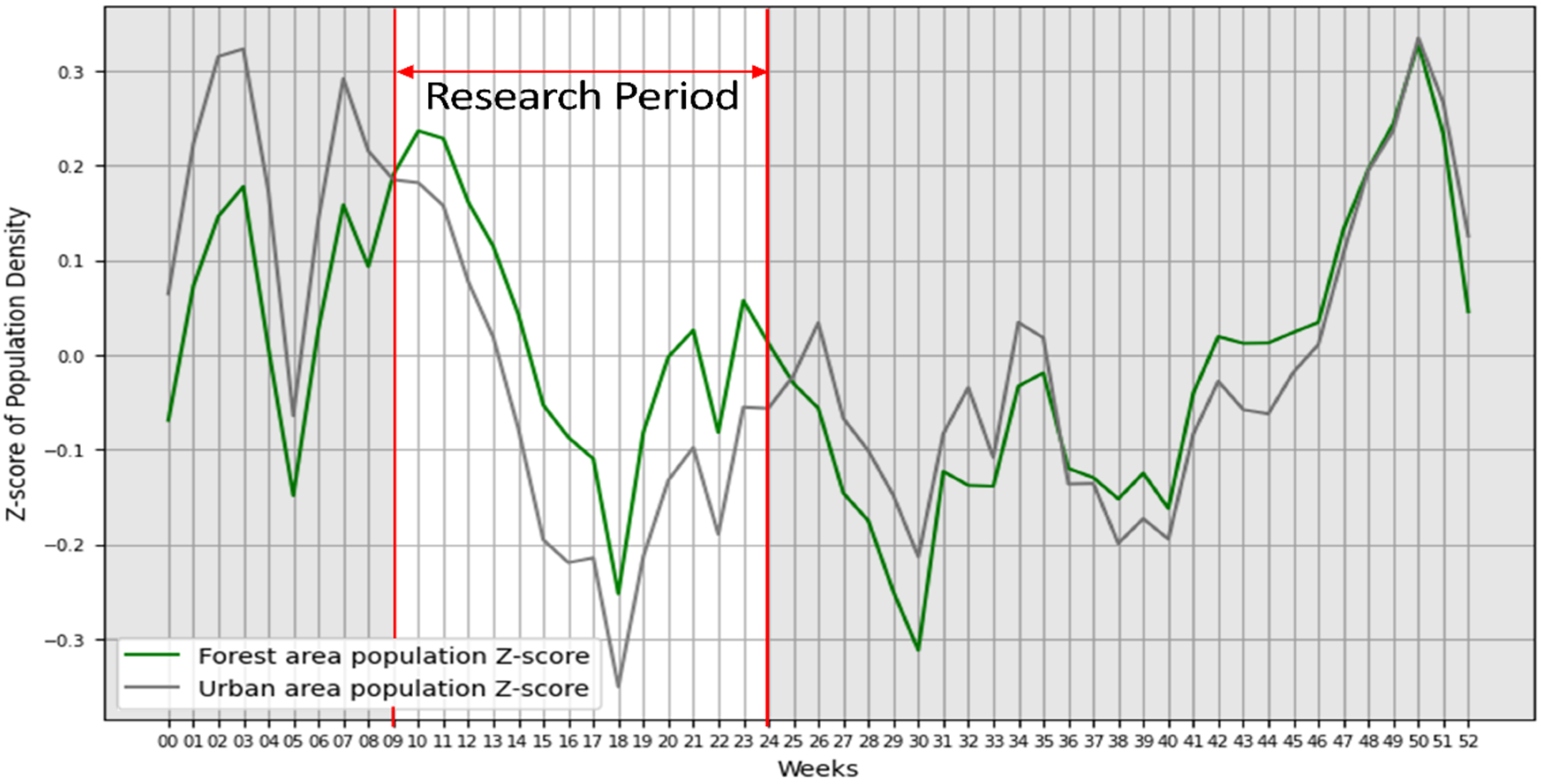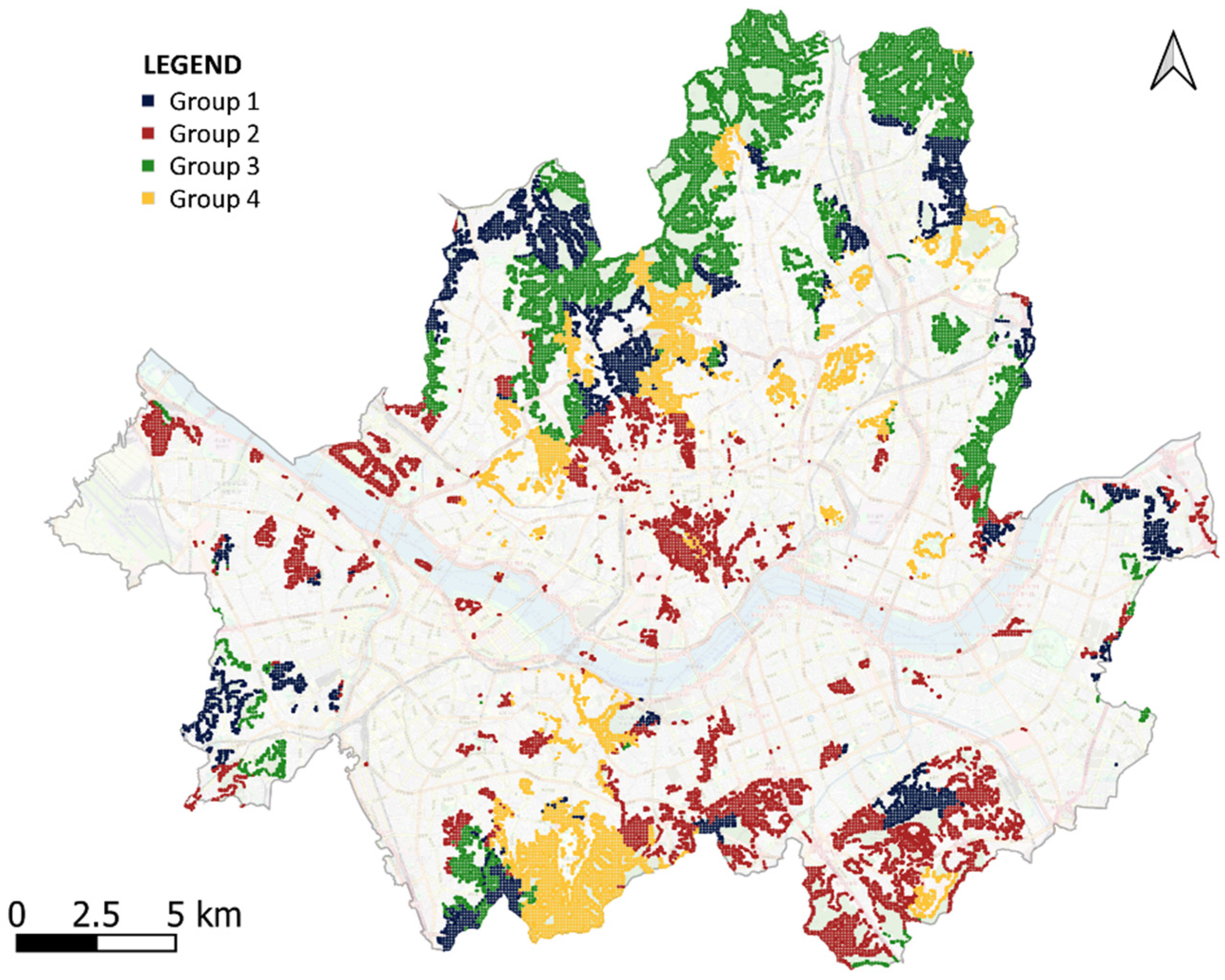Quantitative Evaluation and Typology of Social Exposure Patterns to Urban Green Spaces: A Case Study of Seoul
Abstract
1. Introduction
- How are urban forests in Seoul quantitatively distributed across different times of the day and among diverse population groups?
- What insights can a Gaussian-based 2SFCA accessibility analysis offer for urban forest management and policymaking?
2. Theory and Review of Previous Studies
2.1. Urban Forests and Social Exposure
2.2. Accessibility and Patterns of Social Exposure
2.2.1. The Concept of Accessibility and the Methodology of 2SFCA (G2SFCA)
2.2.2. Application of the K-Means Clustering Algorithm
3. Methodology
3.1. Data Collection
3.1.1. Green Space Data
3.1.2. Population Data: Pedestrian Network Data
3.2. Analysis of Seasonal Variability in Urban Forest Social Exposure
3.3. Typology and Characteristic Analysis of Social Exposure to Urban Forests
- Step 1:
- Calculate the building-level accessibility index.
- Step 2:
- Calculate the green space-level accessibility index.
- It overcomes the limitations of simple distance-based accessibility evaluations by accurately incorporating the distance decay effect using a Gaussian density function.
- It evaluates accessibility changes according to the time of day, age, and sex, allowing for a detailed analysis of social exposure patterns in urban forest usage.
- Beyond traditional demand-oriented accessibility analyses, the algorithm assesses how each green space is exposed to diverse population groups from a supply-side perspective, thereby providing practical insights into urban forest management and resource allocation strategies.
| Algorithm 1 Gaussian based 2SFCA for Supply Perspective |
| Input: List of buildings , List of green spaces , Gaussian function parameters |
| Output: Accessibility index for each building and green space |
| Step 1: Calculate building-level accessibility index |
| for each building ∈ do |
| Initialize weighted_green_area ← 0 |
| for each green space ∈ within catchment_area of do |
| ← distance between and |
| ← Gaussian weight for |
| weighted_green_area ← weighted_green_area + (area of × ) |
| end for |
| if weighted_green_area = 0 then |
| ← 0 (No accessible green spaces) |
| else |
| ← population of /weighted_green_area |
| end if |
| end for |
| Step 2: Calculate green-space-level accessibility index |
| for each green space ∈ do |
| Initialize total_accessibility ← 0 |
| for each building ∈ within catchment_area of : |
| ← distance between and |
| ← Gaussian weight for |
| total_accessibility ← total_accessibility + (× ) |
| end for |
| ← total_accessibility |
| end for |
| Return: Accessibility index for all buildings and for all green spaces |
4. Results
4.1. Analysis of Seasonal Variability in Social Exposure to Urban Forests
4.2. Quantitative Categorization of Social Exposure to Urban Forests Based on the G2SFCA Methodology
4.3. Analysis of the Characteristics of Social Exposure Quantification by Type in Urban Forests Based on G2SFCA
5. Discussion
6. Conclusions
- Type A:
- School-age children using green spaces near schools (weekday daytime).
- Type B:
- Working-age adults utilizing urban forests during commuting and leisure hours.
- Type C:
- Older adults favoring large-scale green spaces and neighborhood parks (morning).
- Type D:
- Young adults frequenting small urban parks and rest areas at various times.
Author Contributions
Funding
Data Availability Statement
Conflicts of Interest
Abbreviations
| 2SFCA | Two-Step Floating Catchment Area |
| USGS SRTM | US Geological Survey Shuttle Radar Topography Mission |
References
- Taylor, L.; Hochuli, D.F. Defining greenspace: Multiple uses across multiple disciplines. Landsc. Urban Plan. 2017, 158, 25–38. [Google Scholar] [CrossRef]
- Ekkel, E.D.; de Vries, S. Nearby green space and human health: Evaluating accessibility metrics. Landsc. Urban Plan. 2017, 157, 214–220. [Google Scholar] [CrossRef]
- Bratman, G.N.; Anderson, C.B.; Berman, M.G.; Cochran, B.; de Vries, S.; Flanders, J.; Folke, C.; Frumkin, H.; Gross, J.J.; Hartig, T.; et al. Nature and mental health: An ecosystem service perspective. Sci. Adv. 2019, 5, eaax0903. [Google Scholar] [CrossRef] [PubMed]
- Lafortezza, R.; Chen, J.; van den Bosch, C.K.; Randrup, T.B. Nature-based solutions for resilient landscapes and cities. Environ. Res. 2018, 165, 431–441. [Google Scholar] [CrossRef]
- Apparicio, P.; Cloutier, M.S.; Shearmur, R. The case of Montréal’s missing food deserts: Evaluation of accessibility to food supermarkets. Int. J. Health Geogr. 2007, 6, 4. [Google Scholar] [CrossRef]
- Statistics Korea. Seoul Population Statistics; Statistics Korea: Seoul, Republic of Korea, 2023. [Google Scholar]
- Seoul Metropolitan Government. Green Space Area and Urban Forest Status in Seoul; Seoul Metropolitan Government: Seoul, Republic of Korea, 2023.
- Rigolon, A. A complex landscape of inequity in access to urban parks: A literature review. Landsc. Urban Plan. 2016, 153, 160–169. [Google Scholar] [CrossRef]
- Mitchell, R.; Popham, F. Effect of exposure to natural environment on health inequalities: An observational population study. Lancet 2008, 372, 1655–1660. [Google Scholar] [CrossRef]
- Yoo, E.-H.; Roberts, J.E.; Eum, Y.; Li, X.; Konty, K. Exposure to urban green space may both promote and harm mental health in socially vulnerable neighborhoods: A neighborhood-scale analysis in New York City. Environ. Res. 2022, 204, 112292. [Google Scholar] [CrossRef]
- Haase, D.; Larondelle, N.; Andersson, E.; Artmann, M.; Borgström, S.; Breuste, J.; Gomez-Baggethun, E.; Gren, Å.; Hamstead, Z.; Hansen, R.; et al. A quantitative review of urban ecosystem service assessments: Concepts, models, and implementation. Ambio 2014, 43, 413–433. [Google Scholar] [CrossRef]
- Jennings, V.; Bamkole, O. The relationship between social cohesion and urban green space: An avenue for health promotion. Int. J. Environ. Res. Public Health 2019, 16, 452. [Google Scholar] [CrossRef]
- Grima, N.; Corcoran, W.; Hill-James, C.; Langton, B.; Sommer, H.; Fisher, B. The importance of urban natural areas and urban ecosystem services during the COVID-19 pandemic. PLoS ONE 2020, 15, e0243344. [Google Scholar] [CrossRef] [PubMed]
- Pouso, S.; Borja, Á.; Fleming, L.E.; Gómez-Baggethun, E.; White, M.P.; Uyarra, M.C. Contact with blue-green spaces during the COVID-19 pandemic lockdown beneficial for mental health. Sci. Total. Environ. 2021, 756, 143984. [Google Scholar] [CrossRef] [PubMed]
- Jung, J.-H.; Nam, J. Analysis of population activity types and regional characteristics using location-based big data in Seoul. J. Korea Plan. Assoc. 2019, 54, 75–90. [Google Scholar] [CrossRef]
- Korea Forest Research Institute. Evaluation Study on the Contribution of Forest Welfare Services to National Quality of Life; Korea Forest Research Institute: Seoul, Republic of Korea, 2023. [Google Scholar]
- Millennium Ecosystem Assessment. Ecosystems and Human Well-Being; Island Press: Washington, DC, USA, 2005. [Google Scholar]
- Choi, M.; Jo, J.; Kim, H.J.; Ji, S. Mapping the Unseen: Integrating Hiking Activities Into Spatially Explicit Cultural Ecosystem Service Assessment Through Agent-Based Modeling. Trans. GIS 2025, 29, e13285. [Google Scholar] [CrossRef]
- McGrail, M.R. Spatial accessibility of primary health care utilising the two step floating catchment area method: An assessment of recent improvements. Int. J. Health Geogr. 2012, 11, 50. [Google Scholar] [CrossRef]
- Luo, W.; Wang, F. Measures of spatial accessibility to health care in a GIS environment: Synthesis and a case study in the chicago region. Environ. Plan. B Plan. Des. 2003, 30, 865–884. [Google Scholar] [CrossRef]
- Apparicio, P.; Séguin, A.-M.; Naud, D. The quality of the urban environment around public housing buildings in montréal: An objective approach based on GIS and multivariate statistical analysis. Soc. Indic. Res. 2008, 86, 355–380. [Google Scholar] [CrossRef]
- Chen, X.; Jia, P. A comparative analysis of accessibility measures by the two-step floating catchment area (2SFCA) method. Int. J. Geogr. Inf. Sci. 2019, 33, 1739–1758. [Google Scholar] [CrossRef]
- Delamater, P.L. Spatial accessibility in suboptimally configured health care systems: A modified two-step floating catchment area (M2SFCA) metric. Health Place 2013, 24, 30–43. [Google Scholar] [CrossRef]
- MacQueen, J. Some Methods for Classification and Analysis of Multivariate Observations. In Proceedings of the 5th Berkeley Symposium on Mathematical Statistics and Probability, Berkeley, CA, USA, 21 June–18 July 1965 and 27 December 1965–7 January 1966; University of California Press: Oakland, CA, USA, 1967. [Google Scholar]
- Lloyd, S. Least squares quantization in PCM. IEEE Trans. Inf. Theory 1982, 28, 129–137. [Google Scholar] [CrossRef]
- Arthur, D.; Vassilvitskii, S. K-Means++: The Advantages of Careful Seeding. In Proceedings of the Eighteenth Annual ACM-SIAM Symposium on Discrete Algorithms, New Orleans, LA, USA, 7–9 January 2007; pp. 1027–1035. [Google Scholar]
- Seo, Y.; Lee, G. Estimation of the de Facto Population at the Building Scale Using a Dasymetric Mapping Method Based on GWR. J. Korean Cartogr. Assoc. 2023, 23, 21–34. [Google Scholar]
- Apparicio, P.; Abdelmajid, M.; Riva, M.; Shearmur, R. Comparing alternative approaches to measuring the geographical accessibility of urban health services: Distance types and aggregation-error issues. Int. J. Health Geogr. 2008, 7, 7. [Google Scholar] [CrossRef]
- Kang, J.; Hwang, C. Reproducibility and replicability of GIS and spatial analysis research: A case study of the Journal of the Korean Geographical Society. J. Korean Geogr. Soc. 2022, 57, 425–435. [Google Scholar]
- Goodchild, M.F.; Li, L. Assuring the quality of volunteered geographic information. Spat. Stat. 2012, 1, 110–120. [Google Scholar] [CrossRef]
- Thompson, C.W.; Aspinall, P.; Montarzino, A. The restorative benefits of nearby nature in urban settings. Environ. Behav. 2012, 40, 402–425. [Google Scholar]
- Neuvonen, M.; Sievänen, T.; Tönnes, S.; Koskela, T. Access to green areas and the frequency of visits—A case study in Helsinki. Urban For. Urban Green. 2007, 6, 235–247. [Google Scholar] [CrossRef]
- Walsh, J.A.; Warren, K.S. Selective primary health care: An interim strategy for disease control in developing countries. Soc. Sci. Med. Part C Med Econ. 1980, 14, 145–163. [Google Scholar] [CrossRef]
- Maas, J.; Verheij, R.A.; Groenewegen, P.P.; de Vries, S.; Spreeuwenberg, P. Green space, urbanity, and health: How strong is the relation? J. Epidemiol. Community Health 2006, 60, 587–592. [Google Scholar] [CrossRef]
- Starfield, B.; Shi, L.; Macinko, J. Contribution of primary care to health systems and health. Milbank Q. 2005, 83, 457–502. [Google Scholar] [CrossRef]
- Farber, S.; Morang, M.Z.; Widener, M.J. Temporal variability in transit-based accessibility to supermarkets. Appl. Geogr. 2014, 53, 149–159. [Google Scholar] [CrossRef]
- Kim, H.; Jeon, J. Evaluating public service accessibility using the G2SFCA method. Int. J. Geogr. Inf. Sci. 2021, 35, 267–290. [Google Scholar]
- Ivanova, N. Global Overview of the Application of the Braun-Blanquet Approach in Research. Forests 2024, 15, 937. [Google Scholar] [CrossRef]
- WHO. The World Health Report 2008: Primary Health Care—Now More Than Ever; World Health Organization: Geneva, Switzerland, 2008. [Google Scholar]
- Sugiyama, T.; Leslie, E.; Giles-Corti, B.; Owen, N. Associations of neighbourhood greenness with physical and mental health: Do walking, social coherence and local social interaction explain the relationships? J. Epidemiol. Community Health 2008, 62, e9. [Google Scholar] [CrossRef] [PubMed]







| : Living population at point x | |
| : Living population in census block i | |
| : Population weight at point x (floor area of an individual building/total floor area of aggregation zone i) |
| Data Type | OSM Tags (Predefined OSM Queries for Data Extraction) | Geometry Type |
|---|---|---|
| Green Space | landuse = “forest” OR natural = “wood” Excluded geometries: aeroway = “aerodrome” OR natural = “water” | Polygon |
| Road Network | highway = * AND highway NOT IN [“motorway”, “trunk”, “busway”] | Line |
Disclaimer/Publisher’s Note: The statements, opinions and data contained in all publications are solely those of the individual author(s) and contributor(s) and not of MDPI and/or the editor(s). MDPI and/or the editor(s) disclaim responsibility for any injury to people or property resulting from any ideas, methods, instructions or products referred to in the content. |
© 2025 by the authors. Licensee MDPI, Basel, Switzerland. This article is an open access article distributed under the terms and conditions of the Creative Commons Attribution (CC BY) license (https://creativecommons.org/licenses/by/4.0/).
Share and Cite
Ji, S.; Kim, S.; Lee, J.; Seo, K. Quantitative Evaluation and Typology of Social Exposure Patterns to Urban Green Spaces: A Case Study of Seoul. Forests 2025, 16, 510. https://doi.org/10.3390/f16030510
Ji S, Kim S, Lee J, Seo K. Quantitative Evaluation and Typology of Social Exposure Patterns to Urban Green Spaces: A Case Study of Seoul. Forests. 2025; 16(3):510. https://doi.org/10.3390/f16030510
Chicago/Turabian StyleJi, Sanghoon, Soojin Kim, Jeonghee Lee, and Kyungwon Seo. 2025. "Quantitative Evaluation and Typology of Social Exposure Patterns to Urban Green Spaces: A Case Study of Seoul" Forests 16, no. 3: 510. https://doi.org/10.3390/f16030510
APA StyleJi, S., Kim, S., Lee, J., & Seo, K. (2025). Quantitative Evaluation and Typology of Social Exposure Patterns to Urban Green Spaces: A Case Study of Seoul. Forests, 16(3), 510. https://doi.org/10.3390/f16030510






